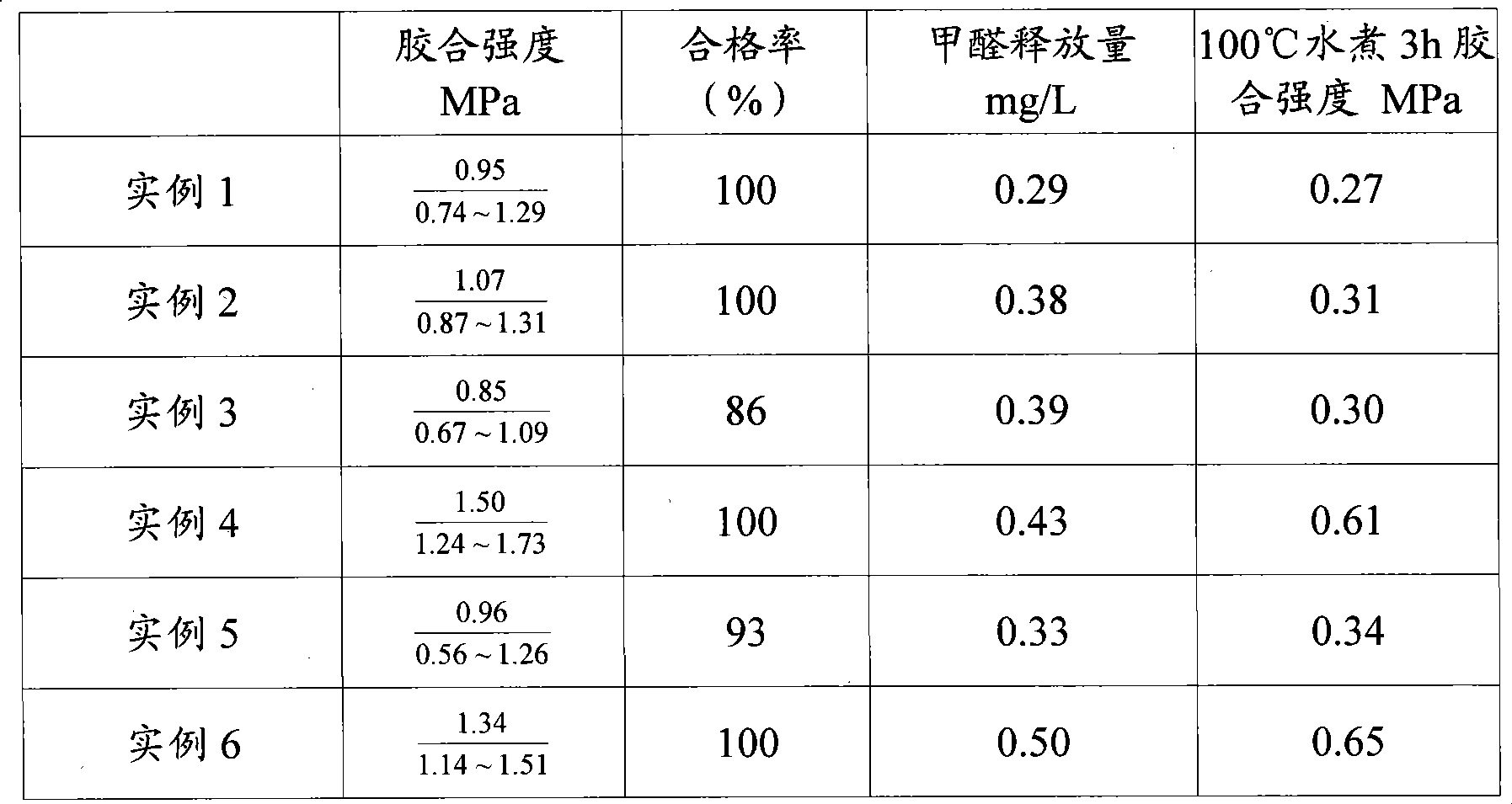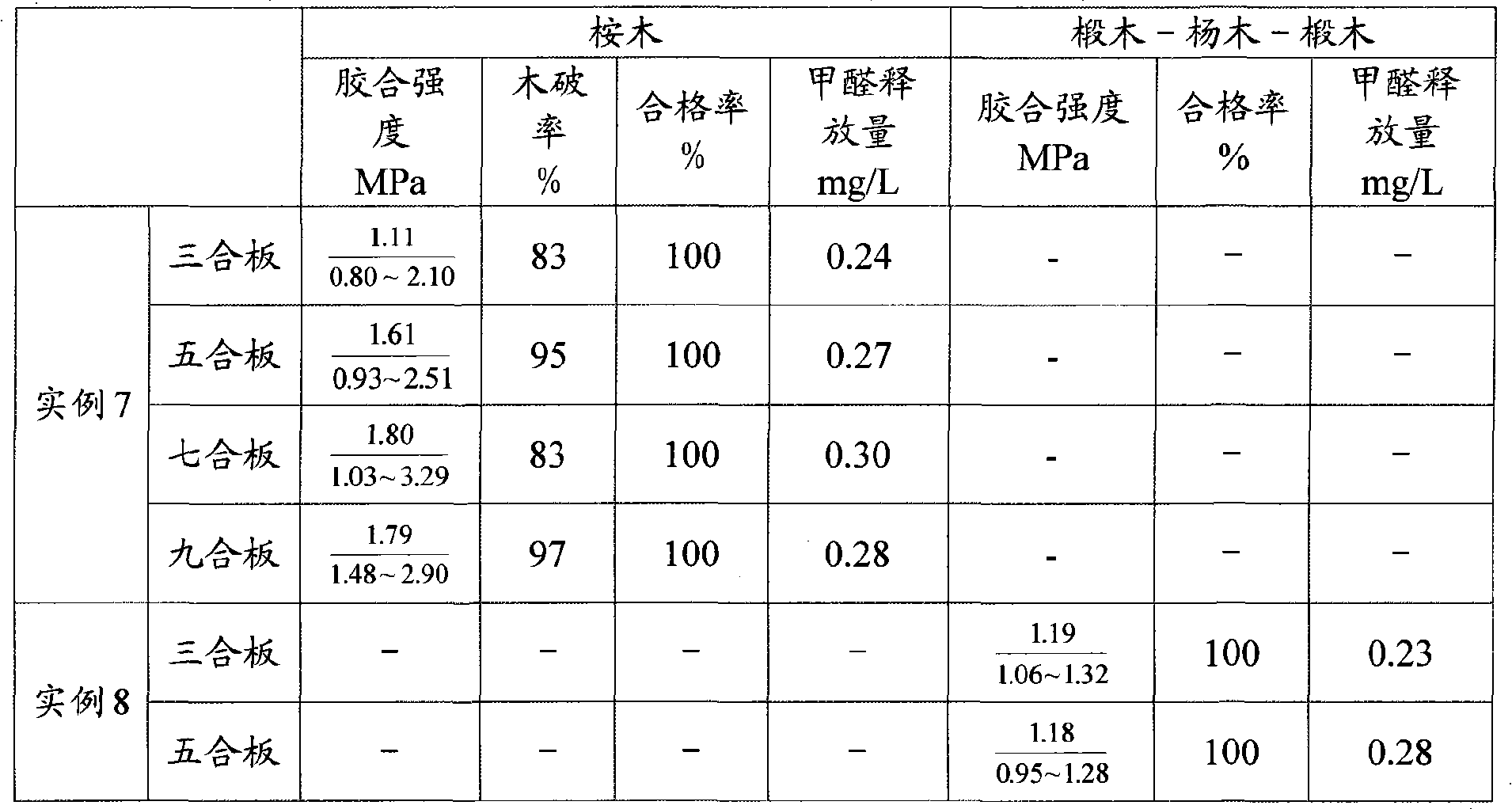Preparation of urea-melamine-formaldehyde resin adhesive for E0 floor
A melamine and formaldehyde resin technology, applied in the direction of adhesives, aldehyde/ketone condensation polymer adhesives, adhesive types, etc., can solve the problems of high cost and complicated operation, prevent hydrolysis speed, reduce formaldehyde emission, The effect of improving the water-resistant adhesive strength
- Summary
- Abstract
- Description
- Claims
- Application Information
AI Technical Summary
Problems solved by technology
Method used
Image
Examples
example 1
[0028] The first step: add 250g of formaldehyde solution, the first batch of melamine 7.5g, and the first batch of urea 84g into the reactor in a 500ml four-necked flask, adjust the pH to 7.5, raise the temperature to 80℃~90℃, and react for 40min.
[0029] Step 2: Adjust the pH to 5.0 and react at 90°C to the desired viscosity.
[0030] The third step: adjust the pH to 6.5, add 7.5 g of the second batch of melamine and 29 g of the second batch of urea, and react at 90°C for 50 minutes.
[0031] Step 4: Adjust the pH to 7.5, add 45g of the third batch of melamine, and react at 80°C for 40 minutes.
[0032]Step 5: Cool down to 70°C, add 29g of the third batch of urea, continue the reaction at 50°C for 30 minutes, and cool to discharge. Test its performance separately, and the results are listed in Table 1. And use 1% NH 4 Cl and 0.5% H 3 PO 4 For the curing agent pressed poplar plywood, the test results are shown in Table 2.
example 2
[0034] The first step: add 250 g of formaldehyde solution, the first batch of melamine 7.5 g, and the first batch of urea 84 g into the reactor in a 500 ml four-necked flask, adjust the pH to 8.0, heat up to 85° C., and react for 45 minutes.
[0035] Step 2: Adjust the pH to 5.5, and react to the desired viscosity at 90°C.
[0036] The third step: adjust the pH to 6.5, add 7.5 g of the second batch of melamine and 24 g of the second batch of urea, and react at 90°C for 50 minutes.
[0037] Step 4: Adjust the pH to 8.0, add 45g of the third batch of melamine, and react at 90°C for 40 minutes.
[0038] The fifth step: Cool down to 70°C, add 24g of the third batch of urea, continue the reaction at 60°C for 30 minutes, and cool and discharge. Test its performance separately, and the results are listed in Table 1. And use 1% NH 4 Cl and 0.5% H 3 PO 4 For the curing agent pressed poplar plywood, the test results are shown in Table 2.
example 3
[0040] The first step: add 250g of formaldehyde solution, 9g of the first batch of melamine, and 84g of the first batch of urea into the reactor in a 500ml four-necked flask, adjust the pH to 9.0, raise the temperature to 90°C, and react for 50min.
[0041] Step 2: Adjust the pH to 5.8, and react to the desired viscosity at 90°C.
[0042] The third step: adjust the pH value to 6.9, add 9 g of the second batch of melamine and 29 g of the second batch of urea, and react at 90°C for 50 min.
[0043] Step 4: Adjust the pH to 9.0, add 52g of the third batch of melamine, and react at 90°C for 40 minutes.
[0044] Step 5: Cool down to 70°C, add 29g of the third batch of urea, continue the reaction at 60°C for 30 minutes, and cool and discharge. Test its performance separately, and the results are listed in Table 1. And use 1% NH 4 Cl and 0.5% H 3 PO 4 For the curing agent pressed poplar plywood, the test results are shown in Table 2.
PUM
 Login to View More
Login to View More Abstract
Description
Claims
Application Information
 Login to View More
Login to View More - R&D
- Intellectual Property
- Life Sciences
- Materials
- Tech Scout
- Unparalleled Data Quality
- Higher Quality Content
- 60% Fewer Hallucinations
Browse by: Latest US Patents, China's latest patents, Technical Efficacy Thesaurus, Application Domain, Technology Topic, Popular Technical Reports.
© 2025 PatSnap. All rights reserved.Legal|Privacy policy|Modern Slavery Act Transparency Statement|Sitemap|About US| Contact US: help@patsnap.com



